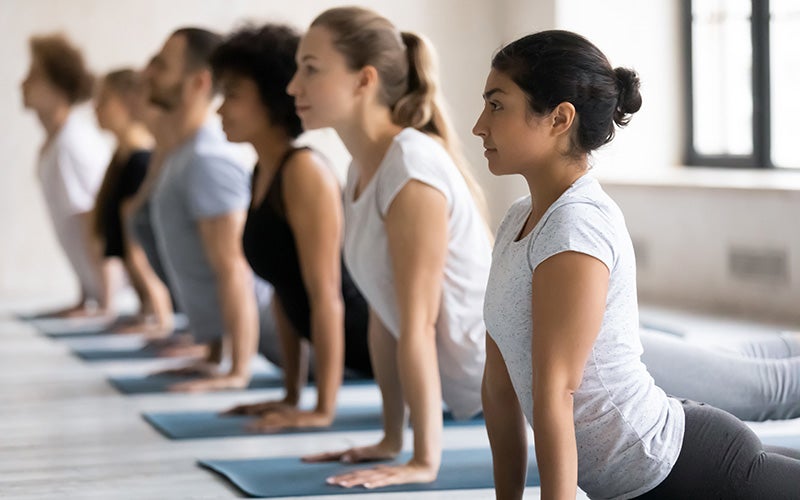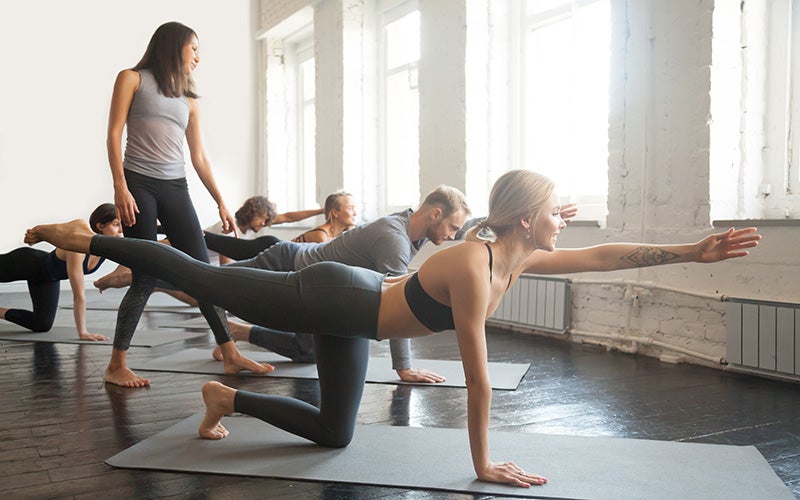13 back strengthening exercises for a lovely limber lumbar
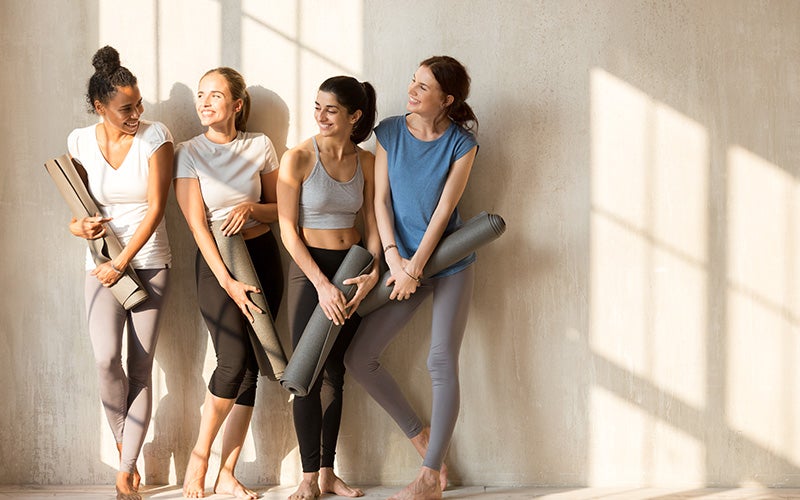 ©fizkes
©fizkes
Can exercise really help you fight back pain? Absolutely! Whether you want to manage a current problem or prevent chronic issues from developing, we’ve gathered the best back strengthening exercises below.
What is the Best Exercise for Back Problems?
Exercises that stretch, strengthen, and improve your torso’s range of motion help alleviate and prevent problems around your spine. A complete workout for the back combines approaches from physical therapy, rehabilitation, and sports science.
At work, you sit at your desk for hours; at home you lift heavy loads, do chores, or play sports outside: as your body’s central supporting organ, your spine is constantly under demand. In addition to natural, age-related physical decline, a lack of exercise, poor posture and asymmetrical strain are often responsible for back problems, and lower back pain affects about 1/3 of adults in the UK.
What Are the Benefits of Back Strengthening Exercises?
When your back develops a sudden twinge or pain is a regular companion, it’s very common to change your posture to compensate. After all, who wants to be in pain all day? Unfortunately, this very shift in your posture is often what prolongs your back pain in the end.
©fizkes
A much more effective approach is to exercise and strengthen your lower back, as weak muscles can often be behind back pain. A solid set of back muscles is the best protection against further back pain. And it’s never too late to get started!
Back exercises should encompass three general areas:
- Stretching: Gentle stretching exercises can relax your spine and relieve acute pain.
- Range of motion: Exercises that make your spine more flexible. An increased range of motion means more blood can circulate to the tissues around your vertebrae, which in turn means the discs between your vertebrae are better supplied with fluid and nutrients.
- Strengthen: Strengthening exercises build up your muscles. A stable musculoskeletal system helps relieve pressure on your joints and intervertebral discs.
In addition to a training plan, make sure you eat a balanced diet as well. Nutrition is just as important for a healthy body as regular exercise. It’s easy to take care of your daily dose of vitamins with our Daily Vitamins – the best bits of fruits and vegetables, condensed into a simple capsule.
Which Muscles Do Back Exercises Train?
A complete set of back exercises should activate and strengthen all the muscles in your torso. This includes not only your back muscles, but also your abdominal muscles, both superficial and deep.
If your abs are too weak to stabilize and support your body, it’s up to your back to compensate. And if that goes on for too long, problems and pain are more likely to flare up.

©jacoblund
Your back exercises should train these muscles:
- Erector spinae / spinal erectors: The term “spinal erectors” encompasses many small and large muscles in the lumbar region to the right and left of the spine. They connect individual vertebrae, as well as the pelvis and ribs. Their main function is to straighten your spine and keep your head upright.
- Musculus latissimus dorsi / “lats”: The musculus latissimus dorsi is your body’s widest muscle. It’s what helps you bring your arms up to your upper body and rotate them inwards, as well as tilt and lift your torso forward – like during pull-ups. It’s also a secondary muscle for exhaling.
- Musculus trapezius / “traps”: The trapezius stabilizes the upper back. Its main function is to control your shoulder blade’s movement. This muscle is also responsible for motion and stability in your upper back.
- Rectus abdominis / frontal abdominal muscle: The frontal abdominal muscle is what gives you a visible six-pack. It’s an important muscle for posture as well. It pulls your chest towards your legs and bends your torso.
- Transversus abdominis / transverse abdominal muscle: The transversus abdominis is also involved in bending your torso: it contracts your abdomen and lowers your ribs. It’s involved in exhalation, too.
- Musculus obliquus internus abdominis, Musculus obliquus externus abdominis / oblique abdominal muscles, internal and external: The oblique abdominal muscles rotate the upper body and contribute to defined abs.
- Musculus quadratus lumborum and Musculus iliopsoas / rear abdominal muscles: The musculus quadratus lumborum inclines the torso to the side. The iliopsoas muscle is the strongest hip flexor, straightening the torso and rotating the thigh outwards.
Who Should Do Back Strengthening Exercises?
Back problems are widespread among adults. They will affect almost everyone at some point in their lives. If you don’t have any problems now, that’s a good sign, of course. But to make sure it stays that way, exercise and strengthen your muscles in a focused way. A solid back strengthening program will help you stay healthy and mobile in the long run.
Back exercises can also help with the following:
- Chronic back pain, neck pain, and headaches
- Minimizing wear and tear on large joints like hips, knees, and shoulders
- Lopsided stress, e.g. from too much sitting at a desk
- Treatment after joint operations
- Prevention or treatment of herniated discs
- Postural disorders, e.g. due to curvature of the spine (scoliosis)
- Osteoporosis
If you’re suffering from acute symptoms – or chronic problems – see a doctor first! They can give you a professional diagnosis and, in the best-case scenario, recommend or prescribe therapy or specific exercises.
13 Exercises for Stretching, Strengthening, and Range of Motion
Back exercises – sitting, standing, or on a mat – come with many advantages: defined abdominal and back muscles, better posture, more relief on your intervertebral discs, and reduced or no back pain.
That’s more than enough reasons for you to work some back strengthening exercises into your routine. For optimum effects, spend 10 to 15 minutes on back exercises, three to five times a week.
Our tip: Have you seen our workout plans and tutorial videos yet? Now you can customize your fitness routine with our free workouts and how-to videos!
Here are the best exercises for stretching and strengthening your back, and improving your range of motion:
1. Improve range of motion
Shoulder circles
Stand with your feet flat on the floor and hip width apart to begin the exercise. Put your fingertips on the shoulder of the same arm and start to circle your arms backwards. Consciously pull your shoulder blades down your back to relieve pressure on your neck. Keep your pelvis stable. It helps if you tense your core: picture pulling your navel towards your ribs. Repeat the movement 15 to 20 times and then change directions.
Rolling Like a Ball
Lie with your back flat on the floor, bend your legs, and hug them with your arms so you form a small ball. Lift your head and shoulders off the floor slightly and rock gently back and forth. Repeat the movement at your own pace for about 30 to 60 seconds.
Cat-Cow
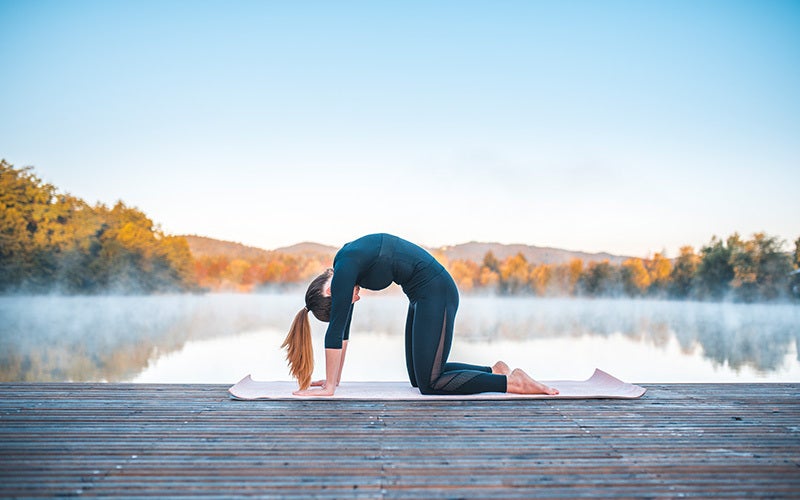
Begin on all fours with your hands below your shoulders, knees below hips. Let your head sink down and, at the same time, round your back completely, arching it like a cat. Raise your head again, stretch it up, and lower into a hollow back. Repeat this cat-cow movement, keeping a steady rhythm, for about one minute.
2. Stretch
Side stretch
Start by standing with your feet hip width apart. Stretch your right arm towards the ceiling. Keep your opposite hand on your waist. Slowly lean your upper body to the left, until your extended arm begins to point to the side. Keep your neck relaxed. You should feel the stretch on the right side of your waist. Hold it for about 30 seconds, return to the starting position, and change sides.
Lumbar stretch
Begin the exercise by sitting upright on a chair or stool. Bend your upper body forward until it rests on your thighs. Let your arms hang down by the sides of your legs and grab your feet with your hands. Hold this relaxation position for about 30 seconds, then slowly roll up vertebra by vertebra. This exercise can help alleviate some pain, especially in the lower back.
If you already have a flexible spine, do this stretch standing to hit your hamstrings as well.
Cobra
Lie down on the mat on your stomach and put your palms down next to your chest with your fingertips pointing forward. Now push up with your arms and slowly straighten your upper body. Keep your pelvis on the floor and your arms slightly bent. Keep your neck as relaxed as possible as an extension of your spine. Hold this position for about 30 seconds. You should feel a stretch in your abdominal wall and lower back.

3. Strengthen
Back extension
Lie on your stomach, with your arms bent and your hands on the back of your head or your temples. Now lift your upper body a few centimeters above the mat. Keep your head steady – an extension of your spine – and your gaze on the floor. Hold this position briefly. Slowly lower your upper body down to the starting position. For more of a challenge, do this exercise with outstretched arms.
Be sure to keep your shoulder blades steady to protect your neck. Repeat 15 to 20 times.
Balancing table
Begin on all fours with hands below shoulders, knees below hips. Extend your right leg behind you while bringing your left arm forward. Bring your knee and elbow together under your torso, then stretch them out again. Make sure that your arm, back, and leg form a straight line at the top of the movement and that you don’t tilt your pelvis. Repeat 15 to 20 times. Return to the starting position and change sides.
©fizkes
Single leg reach
Start in a standing position. Lift one leg and stretch it back. Meanwhile, lean forward with your upper body until it’s parallel to the ground. Build up body tension. You’ll need to engage your lower abdominal and back muscles to keep your balance. Stretch your arms straight forward or out to the side of your body. Your head is an extension of your spine and your neck should be relaxed. It helps if you stabilize your shoulder blades by consciously pulling them down your back. Hold this position for 15 to 30 seconds and return to the starting position. Change sides.
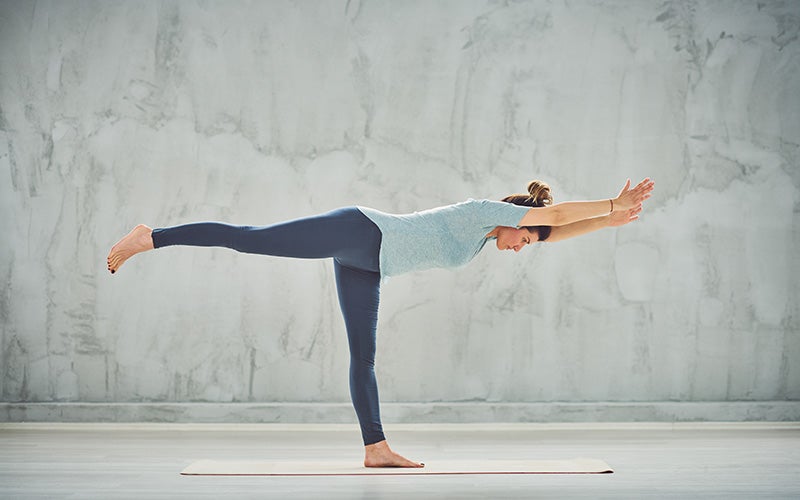
Glute Bridge
To start the glute bridge exercise, lie with your back flat on the mat. Place your feet hip-width apart with your knees bent so that your heels just touch your fingertips. Now lift your hips up until your spine, hips, and thighs form a straight line. To fully exercise the back extensor, raise your shoulder blades slightly. Engage your core to avoid hollowing your back. Hold this upper position for a second. Then lower yourself down without touching your glutes to the floor and repeat the movement 15 to 20 times.
Elbow Plank
Lie on the floor on your stomach and position your elbows under your shoulders. Your forearms are parallel to your body and your fingertips point straight forward. Keep your neck as relaxed as possible and straight as an extension of the spine, fixing your gaze on a point between your hands. Now press your forearms into the floor and push yourself up. Support your body on your toes and forearms only. Build up tension so that your body stays straight – avoid going into either a hollow or rounded back.
Side Plank
Start on your side with your elbow below your shoulder and your forearm parallel to the edge of the mat. Stretch your legs out so that they lie on top of each other and form a straight line with your hips and upper body. Press the outer edge of your lower foot and your forearm into the floor, while pushing your hips up towards the ceiling. Don’t sag! Consciously activate your lateral abdominal muscles and hold this position. Then change sides.
Are you a fan of planking? Then check out our article on plank exercises – with plenty of variations and tips for how to avoid typical mistakes.
Crunches
Lie on your back and put your heels up so that you can just touch them with your fingertips. Make sure that your lower back stays in contact with the floor during the entire exercise. Press your coccyx into the mat to help maintain this position. Put your hands on your head and bring your head towards the ceiling. You should be able to fit a fist between your chin and chest. Using your frontal abdominal muscles, lift your upper back, including the shoulder blades, off the floor, and crunch your abs toward your legs. Breathe out. Hold the tension and slowly lower yourself in a controlled manner while inhaling, keeping your upper back and shoulder blades above the mat at all times. Repeat the exercise 15 to 20 times before returning to the starting position and beginning another set.
Our tip: Pilates is a perfect workout for effectively strengthening both superficial and deeper abdominal muscles.
Conclusion
- A complete workout for back strengthening stretches and strengthens your torso muscles, while improving your range of motion.
- Compensation postures and passive treatments can prolong back pain, while exercise and targeted muscle building can help prevent it.
- Regular exercise for back strengthening can prevent and alleviate pain caused by bad posture, too much sitting, or a general lack of movement.
- Back strengthening programs always include abdominal exercises in addition to the exercises for the upper and lower back. The abdominal muscles are important counterparts to the back extensors, which means they need to be strengthened as well.
- Spend 10 to 15 minutes on these exercises three to five times a week.
Sources for this article
We at foodspring use only high-quality sources, including peer-reviewed studies, to support the facts within our articles. Read our editorial policy to learn more about how we fact-check and keep our content accurate, reliable, and trustworthy.
- (1) https://www.tk.de/resource/blob/2081662/6382c77f2ecb10cc0ae040de07c6807f/gesundheitsreport-au-2020-data.pdf






























